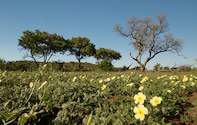
Bunches of dead leaves on a group of leadwood trees appeared to indicate that they had been affected by the low water table. A closer inspection of the individual branches revealed that borer beetles had been at work. Several other tree species were subsequently noted with similar die-off and the phenomenon appears to be more prevalent this season than in previous years. Any other observations would be interesting.
Combretum imberbe - (leadwood) - trees are particularly sensitive to a lowered water table and do not easily adapt. Other trees species with a higher oil content in the leaves, such as most Euclea and some species of Rhus appear more drought resistant but are popular targets for the longhorn beetles. Keep a watch for any trees with unusual clumps of dead leaves and try and identify the cause.
Longhorn Beetles belong to the family Cerambycidae with hundreds of species in at least 16 genera within our region. Ranging in size from five to 100 mm they are all characterised by very long antennae. They are all harmless to humans, apart from the jaws of some of the larger species. Some diurnal species are brightly coloured but most are brown or camouflaged.
They characteristically bore holes into living plant stems in which they lay their eggs. The larvae subsist on sap or heart wood, increasing the diameter of their tunnels as they grow before pupation. They emerge from their wooden prisons at the onset of the rains. Most longhorn larvae are edible and highly nutritious in a survival situation.
Many of the medium sized species bore into the heartwood while others ring-bark the stem to kill the branch. This action seals nutrients into the stem and makes it easier for the larvae to feed and breathe without a sap flow. Unless one actually observes the beetle in action there can only be speculation as to the species involved - guided only by size. Any information relating to the breeding behaviour of any particular species would add to our understanding of these interesting beetles.

 These are just some of the many types of trees found in Kruger Park. The baobab is southern Africa's most distinctive...
These are just some of the many types of trees found in Kruger Park. The baobab is southern Africa's most distinctive...